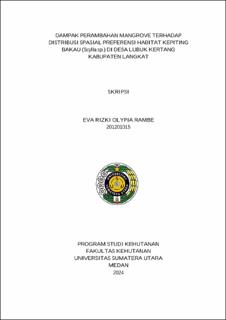Dampak Perambahan Mangrove terhadap Distribusi Spasial Preferensi Habitat Kepiting Bakau (Scylla sp.) di Desa Lubuk Kertang Kabupaten Langkat
The Impact of Mangrove Encroachment on the Spatial Distribution of Habitat Preferences for Mangrove Crabs (Scylla sp.) in Lubuk Kertang Village, Langkat Regency

Date
2024Author
Rambe, Eva Rizki Olypia
Advisor(s)
Sulistiyono, Nurdin
Metadata
Show full item recordAbstract
Mangrove forests are an important part of coastal ecosystems that ensure the lives of residents and water productivity. One of the impacts of mangrove encroachment or conversion on the ecology of mangrove forests is the reduction in habitat for mangrove crabs, which are a key species in determining mangrove succession. By using spatial modeling in the mangrove forest of Lubuk Kertang Village, Brandan District, Langkat Regency, this research aims to analyze the impact of encroachment on the habitat preferences of mangrove crabs (Scylla serrata). Field data was collected using a purposive sampling method with 71 observation plots. The analysis was carried out using the Maximum Entropy algorithm to build a habitat model based on the presence of mangrove crabs and environmental variables such as NDVI, temperature, pH, salinity, dissolved oxygen, mud depth and distance from the river. The preferred habitat area for mud crabs in 2018 (Before encroachment) was 203 Ha, while in 2023 (After encroachment) it was 126 Ha, the preferred habitat category for mud crabs which is very suitable for mud crab habitat. The worsening decline in water quality can be seen in abiotic factors in 2023 where the pH of 5.99 tends to be more acidic due to the weathering of excessive and rotting remains of mangrove leaves, stems and wood as a result of this encroachment. So conditions like this can endanger the survival of the organism because it disrupts metabolism and respiration.
Collections
- Undergraduate Theses [2170]
